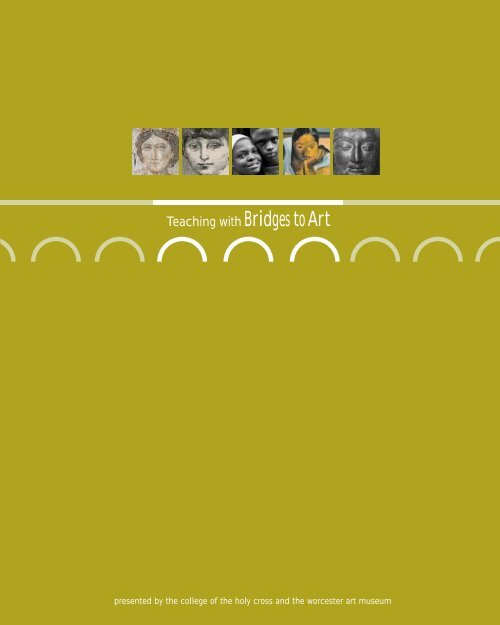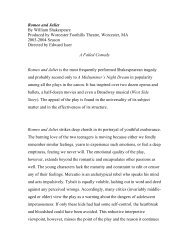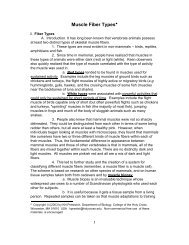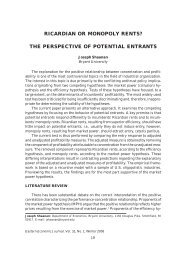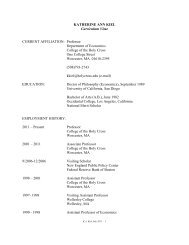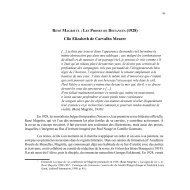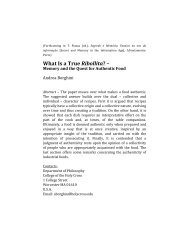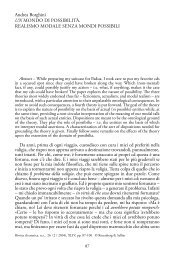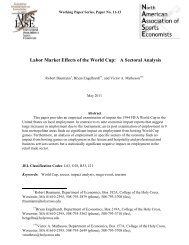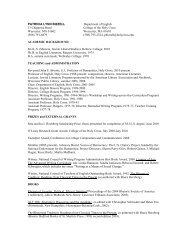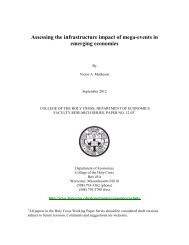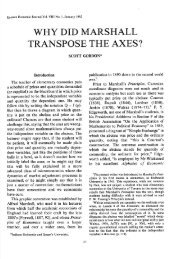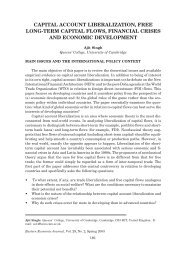worcester hi res - College of the Holy Cross
worcester hi res - College of the Holy Cross
worcester hi res - College of the Holy Cross
Create successful ePaper yourself
Turn your PDF publications into a flip-book with our unique Google optimized e-Paper software.
Teac<strong>hi</strong>ng with Bridges to Art<br />
p<strong>res</strong>ented by <strong>the</strong> college <strong>of</strong> <strong>the</strong> holy cross and <strong>the</strong> <strong>worcester</strong> art museum
Cover left to right:<br />
Kticic Mosaic, House <strong>of</strong> Ge and <strong>the</strong> Seasons, Daphne<br />
(detail), 5 th century, C.E. Marble and limestone<br />
tesserae, 284.8 x 275.6 cm. Antioch Excavation,<br />
1936.35.<br />
Pablo Picasso, 1881-1973, Portrait <strong>of</strong> Fernande<br />
Olivier (detail), 1906, drypoint, 16.20 x 11.80 cm.<br />
Sara S. Garver Fund and anonymous gifts,<br />
1982.82.<br />
Bruce Davidson, born 1933, Untitled (detail),<br />
1966-68, gelatin silver print, 32 x 42.3 cm.<br />
Museum purchase through <strong>the</strong> gift <strong>of</strong> Mrs. Joseph<br />
Goodhue, 1982.14.<br />
Paul Gauguin, 1848-1903, The Brooding Woman<br />
(Te Faaturuma) (detail), 1891, oil on canvas, 91.2<br />
x 68.7 cm. Museum purchase, 1921.186.<br />
Head <strong>of</strong> a Buddha (detail), A.D. 550-77, C<strong>hi</strong>nese<br />
(Henan Province), Nor<strong>the</strong>rn Qi Dynasty, limestone,<br />
44.5 x 27 x 34 cm. Museum purchase,<br />
1914.24.
“The Bridges to Art database contains all <strong>the</strong> ‘<strong>hi</strong>ts’ <strong>of</strong> <strong>the</strong> Museum’s collection<br />
as well as works that <strong>the</strong> Museum visitor will rarely see. Teachers<br />
<strong>of</strong> all subjects—looking for innovative ways to introduce <strong>the</strong> Museum’s<br />
collection to students—will also find t<strong>hi</strong>s database a very useful place to<br />
start planning a visit or creating a new tour. I hope teachers <strong>of</strong> subjects<br />
o<strong>the</strong>r than art—like <strong>hi</strong>story, design, arc<strong>hi</strong>tecture, and even zoology—will<br />
use t<strong>hi</strong>s database as a tool enabling <strong>the</strong>m to use <strong>the</strong> Museum’s enormous<br />
<strong>res</strong>ources to teach more than just art.”<br />
—Mark Lynch, Instructor in <strong>the</strong> Burncoat Arts Magnet Program<br />
at <strong>the</strong> Worcester Art Museum
Table <strong>of</strong> Contents<br />
Letter from <strong>the</strong> Director <strong>of</strong> <strong>the</strong> Worcester Art Museum and<br />
<strong>the</strong> Director <strong>of</strong> Library Services at <strong>Holy</strong> <strong>Cross</strong> 4<br />
Bridges to Art: A Tool for Educators and Students 5<br />
Frameworks: Ideas for Using Bridges to Art 7<br />
A How-to Guide to Bridges to Art 14<br />
Bridges to Art at a Glance—Benefits Hitlist 19<br />
General Information about <strong>the</strong> Worcester Art Museum 20<br />
Edward Savage, 1761-1817, The Savage Family, c. 1779,<br />
oil on canvas, 66.0 x 88.3 cm. Gift <strong>of</strong> William A. Savage,<br />
1964.7<br />
Man <strong>of</strong> Singh Amber, Mughal, ca. 1600, watercolor on<br />
paper, 13.1 x 7.8 cm. Gift <strong>of</strong> Alexander H. Bullock,<br />
1957.7<br />
Claude Monet, 1840-1926, Waterloo Bridge, 1903, oil on<br />
canvas, 65.4 x 92.9 cm. Museum purchase, 1910.37<br />
3
4<br />
Dear Educator,<br />
The Worcester Art Museum and The <strong>College</strong> <strong>of</strong> <strong>the</strong> <strong>Holy</strong> <strong>Cross</strong> are<br />
delighted to bring you Bridges to Art, an exciting new online program. The<br />
Museum and <strong>Holy</strong> <strong>Cross</strong> began t<strong>hi</strong>s ambitious partners<strong>hi</strong>p five years ago<br />
in an endeavor to use technology to bring educational <strong>res</strong>ources to a wider<br />
audience. Museum pr<strong>of</strong>essionals, librarians, and educators worked toge<strong>the</strong>r<br />
toward <strong>the</strong> common goal <strong>of</strong> providing teachers and students remote<br />
access to some <strong>of</strong> <strong>the</strong> Museum’s art collection and all <strong>of</strong> its library<br />
<strong>res</strong>ources. We hope t<strong>hi</strong>s website will enhance your ability to use art across<br />
<strong>the</strong> curriculum and that it also will encourage you to visit and re-visit our<br />
internationally renowned Museum to see <strong>the</strong> works first-hand. As you<br />
explore t<strong>hi</strong>s online learning <strong>res</strong>ource, we believe it will provide you with<br />
many “Bridges to Art” and <strong>the</strong> beginning <strong>of</strong> a lifetime <strong>of</strong> understanding<br />
and enjoying <strong>the</strong> world <strong>of</strong> art.<br />
Sincerely,<br />
James A. Welu,<br />
Director <strong>of</strong> <strong>the</strong> Worcester Art Museum<br />
James E. Hogan,<br />
Director <strong>of</strong> Library Services,<br />
The <strong>College</strong> <strong>of</strong> <strong>the</strong> <strong>Holy</strong> <strong>Cross</strong>
Bridges to Art: A Tool for Educators and Students<br />
Bridges to Art is an innovative educational<br />
website for educators and<br />
students. T<strong>hi</strong>s privately-funded collaborative<br />
project, w<strong>hi</strong>ch was created by<br />
<strong>the</strong> <strong>College</strong> <strong>of</strong> <strong>the</strong> <strong>Holy</strong> <strong>Cross</strong> and <strong>the</strong><br />
Worcester Art Museum, provides electronic<br />
access to <strong>the</strong> Museum’s extensive<br />
art collection and much more.<br />
With each click <strong>of</strong> your mouse, Bridges<br />
to Art will link you to:<br />
• More than 2,000 <strong>hi</strong>gh<strong>res</strong>olution,<br />
printer-ready images<br />
<strong>of</strong> Museum artworks.<br />
• Worcester Art Museum and <strong>Holy</strong><br />
<strong>Cross</strong> library catalogs.<br />
• Supplementary materials such as<br />
maps, charts, letters, conservation<br />
reports, and o<strong>the</strong>r<br />
documentation, and links to<br />
o<strong>the</strong>r online learning <strong>res</strong>ources.<br />
T<strong>hi</strong>s rich teac<strong>hi</strong>ng aid and reference<br />
source fulfills <strong>the</strong> needs <strong>of</strong> educators at<br />
all levels. Teachers and students can use<br />
<strong>the</strong> website to enhance <strong>the</strong> curriculum,<br />
prepare for a tour <strong>of</strong> <strong>the</strong> Museum, or<br />
to continue enjoying <strong>the</strong> Museum’s<br />
<strong>res</strong>ources after a visit or field trip.<br />
The Bridges to Art database has depth<br />
and breadth. You can view artwork<br />
that is regularly on display as well as<br />
works that are <strong>of</strong>f view, including <strong>the</strong><br />
Museum’s extensive works-on-paper<br />
collection, w<strong>hi</strong>ch is not on regular display<br />
due to conservation concerns.<br />
The online displays include works in<br />
all media—paintings, sculptu<strong>res</strong>, decorative<br />
arts, prints, drawings, and<br />
photographs—spanning fifty centuries<br />
<strong>of</strong> art from cultu<strong>res</strong> around <strong>the</strong> world.<br />
Teachers can search <strong>the</strong> database to<br />
enliven instruction on a specific time<br />
period such as Medieval or<br />
Renaissance, to illustrate a culture such<br />
as ancient Egypt or Rome, or to<br />
explore <strong>the</strong> works <strong>of</strong> a particular artist,<br />
school, medium, technique, or style.<br />
Each work <strong>of</strong> art in <strong>the</strong> online arc<strong>hi</strong>ve<br />
also is inventoried by multiple subject<br />
keywords including <strong>the</strong>mes, ideas,<br />
actions, and media. T<strong>hi</strong>s enables you<br />
to <strong>res</strong>earch and explore Museum works<br />
in whatever area or discipline you<br />
wish—<strong>hi</strong>story, literature, sociology,<br />
science, and o<strong>the</strong>r fields relevant to<br />
your instruction. You also can conduct<br />
simple searches using thousands <strong>of</strong><br />
o<strong>the</strong>r subject keywords such as armor,<br />
birds, brushwork, caricature, mourning<br />
customs, music, mythology,<br />
peasants, perspective, physicians,<br />
poverty, Romanticism, and women.<br />
In addition to providing library<br />
Student Artwork<br />
5
Georges Braque 1882-1963, Olive Trees, oil on canvas,<br />
38 x 46.3 cm. Gift from <strong>the</strong> estate <strong>of</strong> Mrs. Aldus Chapin<br />
Higgins, 1970.122<br />
6<br />
<strong>res</strong>ources that will broaden <strong>the</strong> school<br />
learning experience and stimulate<br />
visual literacy, Bridges to Art provides<br />
links to many o<strong>the</strong>r art-oriented websites<br />
and online sources <strong>of</strong> scholarly<br />
materials.<br />
In a nutshell, Bridges to Art utilizes<br />
accessible electronic technology to provide<br />
you and your students with<br />
multiple pathways to <strong>the</strong> wide world <strong>of</strong><br />
art and knowledge.<br />
Ways to use Bridges to Art at a glance:<br />
• Subject searches around <strong>the</strong>mes,<br />
periods, cultu<strong>res</strong>, and media.<br />
• Pre-visit planning or post-visit<br />
explorations.<br />
• Downloading and printing<br />
Museum images.<br />
• <strong>Cross</strong>-cultural comparing and<br />
contrasting.<br />
• Creating real or virtual Museum<br />
<strong>the</strong>me tours.
Frameworks: Ideas for using Bridges to Art<br />
Research any <strong>the</strong>me…and put yourself and your students into <strong>the</strong> framework.<br />
The following sample lessons geared to three age groups—elementary, middle<br />
school, and <strong>hi</strong>gh school—will give you an idea <strong>of</strong> how you can enrich your<br />
curriculum with Bridges to Art. As <strong>the</strong>se examples demonstrate, Bridges to Art can<br />
help you meet some <strong>of</strong> <strong>the</strong> following educational goals:<br />
• Assisting students in making cross-cultural and interdisciplinary<br />
connections.<br />
• Helping students to see and understand art in a global cultural context.<br />
• Teac<strong>hi</strong>ng students how to use technology to gain access to images and<br />
information.<br />
• Helping students to experience <strong>the</strong> social relevance <strong>of</strong> art to <strong>the</strong>ir everyday<br />
lives.<br />
Master <strong>of</strong> <strong>the</strong> 1518/Master <strong>of</strong> <strong>the</strong> Female Half-Lengths,<br />
Rest on <strong>the</strong> Flight into Egypt (detail), 16 th century, oil on<br />
wood panel transferred to canvas, 68.20 x 96.60 cm.<br />
Stoddard Acquisition Fund, 1995.15<br />
Student Artwork<br />
7
Food for thought:<br />
1) What is a family?<br />
2) What are families like in o<strong>the</strong>r<br />
parts <strong>of</strong> <strong>the</strong> world?<br />
3) Why are families a major subject<br />
<strong>of</strong> art? How do different<br />
cultu<strong>res</strong> rep<strong>res</strong>ent families in <strong>the</strong>ir<br />
art?<br />
4) What is a portrait? Have you<br />
ever had your portrait done or had<br />
a family picture taken? Why do<br />
you t<strong>hi</strong>nk <strong>the</strong> portrait <strong>of</strong> <strong>the</strong> fa<strong>the</strong>r,<br />
John Freake, was done separately<br />
from <strong>hi</strong>s wife and baby?<br />
8<br />
The Family in Art: Putting Yourself in <strong>the</strong> Picture—Grades K-5<br />
The following example could be used<br />
as a pre-visit lesson or as part <strong>of</strong> a classroom<br />
unit on <strong>the</strong> family.<br />
(Note: See Massachusetts framework<br />
for <strong>hi</strong>story and social studies—Grade<br />
1—Families and Communities, Now<br />
and Long Ago, Near and Far.)<br />
Mrs. Elizabeth Freake and Baby Mary,<br />
one <strong>of</strong> <strong>the</strong> Museum’s most well-known<br />
paintings, was painted by an anonymous<br />
artist in <strong>the</strong> late 17th century<br />
and depicts a baby and mo<strong>the</strong>r from<br />
Colonial America. The painted portrait<br />
could easily serve as <strong>the</strong> starting<br />
point for discussions about<br />
parent/c<strong>hi</strong>ld relations<strong>hi</strong>ps and <strong>the</strong><br />
issues <strong>of</strong> contrasting fas<strong>hi</strong>ons and<br />
lifestyles from Colonial times to now.<br />
Begin your search:<br />
Search <strong>the</strong> Museum database <strong>of</strong> images<br />
using some <strong>of</strong> <strong>the</strong> following<br />
subject/keyword searches: (Note: See<br />
how-to section on page 14 for an<br />
explanation <strong>of</strong> subject and keyword<br />
searc<strong>hi</strong>ng.)<br />
Family in art<br />
C<strong>hi</strong>ldren in art<br />
Fa<strong>the</strong>rs in art<br />
Mo<strong>the</strong>rs in art<br />
Youth in art<br />
Mo<strong>the</strong>r and c<strong>hi</strong>ld<br />
Anonymous Artist, American, late 17 th century, Mrs. Freake<br />
and Baby Mary, 1671-74, oil on canvas, 107.9 x 93.4 cm. Gift<br />
<strong>of</strong> Mr. and Mrs. Albert W. Rice, 1963.134.<br />
Infants in art<br />
Portrait<br />
C<strong>hi</strong>ldren in art retrieves 80 image titles<br />
from nine cultu<strong>res</strong>—American,<br />
Dutch, British, Japanese, Italian,<br />
French, Australian, Spanish, and<br />
German.<br />
Note: As you pull up <strong>the</strong> images from a<br />
subject or keyword search, each work<br />
<strong>of</strong> art you click on will provide a list <strong>of</strong><br />
additional subjects that you can search<br />
on to expand or narrow your search.
For example, <strong>the</strong> subject Pr<strong>of</strong>ile portraits<br />
retrieves a portrait title that lists<br />
Egyptian portraits as a subject.<br />
Refine your search <strong>of</strong> subjects/<br />
keywords:<br />
Portrait drawing<br />
Portrait painting<br />
Pr<strong>of</strong>ile portraits<br />
Mo<strong>the</strong>rs and sons<br />
Fa<strong>the</strong>rs and daughters<br />
Middle-class families<br />
Refine your search <strong>of</strong> subjects/<br />
keywords even fur<strong>the</strong>r:<br />
Family in art and Japanese<br />
Family and Spanish<br />
<strong>Holy</strong> family<br />
Cassatt Mary and family<br />
Portrait painting—Dutch<br />
Portrait drawing—19th century<br />
Portraits, African<br />
Sons or daughters<br />
Portrait and Copley<br />
Pr<strong>of</strong>ile portraits, American<br />
Ideas for projects: Putting<br />
Yourself in <strong>the</strong> Picture<br />
1) Create a birth announcement<br />
for Baby Mary or for yourself, or<br />
make a drawing from your baby<br />
picture. What and how would you<br />
want to tell <strong>the</strong> world about your<br />
birth?<br />
2) Draw or paint a self- or family<br />
portrait. How is your portrait similar<br />
to or different from <strong>the</strong> portrait<br />
<strong>of</strong> Baby Mary or o<strong>the</strong>r portraits you<br />
found online or saw at <strong>the</strong><br />
Museum? Did you d<strong>res</strong>s your baby<br />
in handmade clo<strong>the</strong>s, such as<br />
those that Baby Mary wears, or in<br />
mass-produced clo<strong>the</strong>s with a<br />
designer label?<br />
3) Use a pencil or pen to create<br />
a pr<strong>of</strong>ile portrait <strong>of</strong> a friend.<br />
top, bottom: Student Artwork<br />
9
Food for thought:<br />
1) What does <strong>the</strong> artwork you<br />
found tell you about life and<br />
times in o<strong>the</strong>r places?<br />
2) Have you ever visited <strong>the</strong><br />
actual location or <strong>the</strong> site <strong>of</strong> one<br />
<strong>of</strong> <strong>the</strong>se paintings? If so, how<br />
does your experience differ from<br />
<strong>the</strong> painter’s experience? If you<br />
were going to move to one <strong>of</strong><br />
those places, where would you go<br />
and why?<br />
3) Can you find individuals in<br />
any <strong>of</strong> <strong>the</strong>se landscapes? What is<br />
<strong>the</strong> relations<strong>hi</strong>p <strong>of</strong> <strong>the</strong> individual<br />
to <strong>the</strong> land?<br />
4) What happens to a rural area<br />
when industry moves in? How do<br />
artists convey <strong>the</strong>ir ideas about<br />
specific places and landscapes in<br />
<strong>the</strong>ir art?<br />
5) How much should we protect<br />
<strong>the</strong> environment from development?<br />
Should we drill for oil on<br />
federally-protected lands in<br />
Alaska?<br />
Exploring <strong>the</strong> Landscape in Art—Grades 6-8<br />
The following example could be used<br />
as a pre-visit lesson or as part <strong>of</strong> a classroom<br />
exploration <strong>of</strong> urban and rural<br />
life. (See Massachusetts frameworks in<br />
<strong>hi</strong>story and social science, including<br />
U.S. geography, elective units in arc<strong>hi</strong>tecture<br />
<strong>of</strong> early and classical<br />
civilization, and world <strong>hi</strong>story and<br />
geography.)<br />
Willows by <strong>the</strong> Uji Bridge, painted with<br />
ink by an anonymous Japanese artist in<br />
<strong>the</strong> early 17th century, depicts an emotional<br />
<strong>res</strong>ponse to a site renowned for<br />
its beauty. Compare t<strong>hi</strong>s painting to<br />
Blossom Restaurant, 103 Bowery,<br />
Manhattan, a photograph taken by an<br />
American artist Berenice Abbott in<br />
1935. These images as well as o<strong>the</strong>rs in<br />
<strong>the</strong> database will inspire explorations <strong>of</strong><br />
rural and urban lifestyles in <strong>the</strong> United<br />
States and in o<strong>the</strong>r areas <strong>of</strong> <strong>the</strong> world.<br />
The dates <strong>of</strong> <strong>the</strong> artworks provide an<br />
<strong>hi</strong>storical context for inquiry, as students<br />
discover wide cultural and<br />
<strong>hi</strong>storical differences in how art depicts<br />
life in <strong>the</strong> country and city.<br />
Anonymous Town Painter, Japanese, active 17 th century,<br />
Willows by <strong>the</strong> Uji Bridge (detail), pair <strong>of</strong> six-panel folding<br />
screens; ink, color, and gold on paper, 154.4 x 323.6 cm.<br />
Alexander H. Bullock Fund, 1969.110.2<br />
Begin your search:<br />
Search <strong>the</strong> Museum database <strong>of</strong> images<br />
using some <strong>of</strong> <strong>the</strong> following<br />
subject/keyword searches: (Note: See<br />
how-to section on page 14 for an<br />
explanation <strong>of</strong> subject and keyword<br />
searc<strong>hi</strong>ng.)<br />
Landscape in art<br />
Arc<strong>hi</strong>tecture in art<br />
Urban<br />
Rural<br />
Cities and towns in art<br />
Boston<br />
Manhattan<br />
The subject term Landscape in art<br />
retrieves 179 image titles from many<br />
different cultu<strong>res</strong>.<br />
Note: As you pull up <strong>the</strong> images from a<br />
subject or keyword search, each work
<strong>of</strong> art you click on will provide a list <strong>of</strong><br />
additional subjects that you can search<br />
on to expand or narrow your search.<br />
For example, <strong>the</strong> subject pastoral art<br />
retrieves a pastoral image that lists<br />
peasants in art as a subject.<br />
Refine your search <strong>of</strong> subjects/<br />
keywords:<br />
Landscape painting<br />
Landscape photography<br />
Plein-air painting<br />
Pastoral art<br />
Summer in art<br />
Buildings in art<br />
Streets in art<br />
Horses in art<br />
Factories in art<br />
Refine your search <strong>of</strong> subjects/<br />
keywords even fur<strong>the</strong>r:<br />
Landscape painting, Japanese<br />
Arc<strong>hi</strong>tecture and Italy<br />
Arc<strong>hi</strong>tecture, got<strong>hi</strong>c<br />
Landscape drawing—20th century<br />
Landscape prints—19th century<br />
Birds or fish<br />
Trees in art and C<strong>hi</strong>nese<br />
Gardens in art and Dutch<br />
Cole and landscape or Bierstadt and<br />
Landscape<br />
Horses in art and Flemish<br />
right: Student Artwork<br />
Ideas for projects:<br />
Putting Yourself in <strong>the</strong> Landscape<br />
1) Work in a small group to draw up<br />
<strong>the</strong> plans for an ideal city for people to<br />
live in. What will you include in your<br />
city and why?<br />
2) Pretend you are in one <strong>of</strong> <strong>the</strong><br />
urban or rural landscapes that you<br />
found online. Write a description <strong>of</strong><br />
<strong>the</strong> landscape and tell a story about<br />
<strong>the</strong> place. How does it feel to be<br />
<strong>the</strong>re? How do you t<strong>hi</strong>nk <strong>the</strong> artist felt<br />
when he/she created <strong>the</strong> work <strong>of</strong> art?<br />
3) Take a picture or do a sketch <strong>of</strong> a<br />
street scene near where you live. Send<br />
or give your picture or sketch with a<br />
description <strong>of</strong> that scene to a friend or<br />
family member.<br />
Berenice Abbott, 1898-1901, Blossom Restaurant, 103<br />
Bowery, Manhattan, 1935, gelatin-silver print,<br />
19.3 x 24.4 cm. Gift <strong>of</strong> Dr. and Mrs. Robert A.<br />
Johnson, 1988.23.<br />
4) Get some pictu<strong>res</strong> and descriptions <strong>of</strong> local homes from a real estate agent.<br />
How would you as a real estate agent evaluate and value a house or property in<br />
one <strong>of</strong> <strong>the</strong> landscape paintings? Do you t<strong>hi</strong>nk any <strong>of</strong> <strong>the</strong> landscape paintings were<br />
done to advertise <strong>the</strong> value <strong>of</strong> a particular place or property? If not, why did <strong>the</strong><br />
artists paint <strong>the</strong>m?<br />
11
Food for thought:<br />
Use searches <strong>of</strong> <strong>the</strong> Bridges to Art database<br />
to explore some <strong>of</strong> <strong>the</strong> following questions<br />
and issues:<br />
1) What can you learn from your<br />
database searches about male and<br />
female roles as depicted in art? How<br />
do <strong>the</strong>se roles vary from culture to culture?<br />
Do an in-depth comparison <strong>of</strong> <strong>the</strong><br />
images <strong>of</strong> women and men in two cultu<strong>res</strong>.<br />
2) In a search for hairstyles or beauty<br />
in art, do you find more images <strong>of</strong><br />
women or men? What conclusions can<br />
you draw about standards <strong>of</strong> beauty—<br />
norms, expectations, and<br />
p<strong>res</strong>su<strong>res</strong>—for women and men in different<br />
cultu<strong>res</strong> and as reflected in art?<br />
3) Are <strong>the</strong> portraits <strong>of</strong> colonels, captains,<br />
and generals men or women?<br />
How does art communicate and promote<br />
certain social viewpoints,<br />
practices, norms, and values?<br />
4) As you search <strong>the</strong> database, what<br />
do you observe about <strong>the</strong> subject matter<br />
<strong>of</strong> <strong>the</strong> art? Do you notice anyt<strong>hi</strong>ng<br />
about how <strong>the</strong> database and its subjects<br />
are organized? How are decisions<br />
made about what to collect, p<strong>res</strong>erve,<br />
and display in a museum or on a website?<br />
Framing Social Issues: Images <strong>of</strong> Women and Men in Art—Grades 9-12<br />
The following example could be used<br />
as a pre-visit lesson or as part <strong>of</strong> classroom<br />
discussions on gender, war, or<br />
museum collections. (See<br />
Massachusetts frameworks in <strong>hi</strong>story<br />
and social science including geography,<br />
<strong>hi</strong>story, and related studies from<br />
c. 500 AD to <strong>the</strong> p<strong>res</strong>ent. Also, see<br />
Arts framework for its goal that students<br />
understand <strong>the</strong> roles <strong>of</strong> artists,<br />
patrons, cultural organizations, and<br />
art institutions in societies <strong>of</strong> <strong>the</strong> past<br />
and p<strong>res</strong>ent.)<br />
Begin your search:<br />
Search <strong>the</strong> Museum database <strong>of</strong> images<br />
using some <strong>of</strong> <strong>the</strong> following<br />
subject/keyword searches: (Note: See<br />
how-to section on page 14 for an<br />
explanation <strong>of</strong> subject and keyword<br />
searc<strong>hi</strong>ng.)<br />
Charles Coypel, 1694-1752, Portrait <strong>of</strong> Charlotte P<strong>hi</strong>lippine de<br />
Chatre de Cange, Marquise de Lamure, about 1735, pastel on<br />
blue wove paper, laid down on linen, 75.5 x 61.9 cm.<br />
Bequea<strong>the</strong>d by Mary G. Ellis as part <strong>of</strong> <strong>the</strong> Theodore T. and<br />
Mary G. Ellis Collection, 1940.61.<br />
Women in art<br />
Men in art<br />
Love in art<br />
Aes<strong>the</strong>tics in art<br />
Beauty<br />
Samplers in art<br />
Fas<strong>hi</strong>on in art<br />
Costume in art<br />
War in art<br />
Revolution in art<br />
Refine your search <strong>of</strong> subjects/<br />
keywords:<br />
Feminine beauty (aes<strong>the</strong>tics)<br />
Men’s clot<strong>hi</strong>ng<br />
Beauty, personal<br />
Hairstyles in art<br />
Cosmetics in art<br />
Beauty and men<br />
Military services<br />
Civil war<br />
Soldiers in art<br />
Portraits and war<br />
Generals or captains<br />
Refine your search <strong>of</strong> subjects/<br />
keywords even fur<strong>the</strong>r:<br />
Fas<strong>hi</strong>on, Japanese<br />
Hairstyles and C<strong>hi</strong>nese<br />
Hairstyles and men in art<br />
Women and clot<strong>hi</strong>ng and British<br />
center:<br />
Prince Arikankharer Slaying His Enemies, A.D. 25-41, Meroitic,<br />
sandstone, 21.4 x 25.4 x 4.9 cm. Museum purchase, 1922.145.<br />
below:<br />
Parvati, Consort <strong>of</strong> S<strong>hi</strong>va, 12 th -13 th century, South Indian,<br />
Chola Dynasty, bronze, 50 x 19.2 x 17.5 cm.<br />
Museum purchase, 1928.26.
Armed forces—<strong>of</strong>ficers<br />
Portraits, American and war<br />
Generals and German<br />
Generals—United States<br />
Revolution, American<br />
Ideas for projects:<br />
Framing <strong>the</strong> Questions<br />
1) Look at fas<strong>hi</strong>on shots <strong>of</strong> men and women in Gentleman’s Quarterly and<br />
Vogue. What do <strong>the</strong>y reveal about standards <strong>of</strong> beauty in <strong>the</strong> United States? What<br />
evidence do you find in <strong>the</strong> database for how <strong>the</strong>se standards change over time?<br />
Design and draw a past or future fas<strong>hi</strong>on<br />
design for men’s or women’s hair or<br />
hats.<br />
Jules Cheret, 1836-1932, Palais de Glace Champs-<br />
Elysses,1896, lithograph, 58 x 39 cm, Museum<br />
purchase, 1976.24.<br />
2) Consider yourself an advertising<br />
executive and choose one <strong>of</strong> <strong>the</strong> images<br />
you found online to sell a product.<br />
Design an ad campaign for any product<br />
using your work <strong>of</strong> art.<br />
3) Design and draw football or skateboard<br />
padding using Roman or<br />
medieval armor as inspiration. Or use<br />
<strong>the</strong> portraits you found <strong>of</strong> military leaders<br />
to design <strong>the</strong> perfect military “suit”<br />
for a man or a woman.<br />
4) Why do people collect art or anyt<strong>hi</strong>ng<br />
else? Do you collect anyt<strong>hi</strong>ng, and<br />
how do you display your collection?<br />
Design your own collection <strong>of</strong> images<br />
from <strong>the</strong> database around a particular<br />
inte<strong>res</strong>t or <strong>the</strong>me. T<strong>hi</strong>nk about how you<br />
will evaluate, organize, and display <strong>the</strong><br />
works you select for your ex<strong>hi</strong>bition.<br />
Student Artwork<br />
13
A How-to Guide to Bridges to Art<br />
Getting Started:<br />
• Type in <strong>the</strong> Internet add<strong>res</strong>s:<br />
http://college.holycross.edu/bridgesto<br />
art<br />
• To search <strong>the</strong> Bridges to Art database,<br />
click on Search Databases.<br />
You can also access t<strong>hi</strong>s manual<br />
online by clicking on Teac<strong>hi</strong>ng<br />
Manual under Tools for Educators.<br />
• Select <strong>the</strong> database, Worcester Art<br />
Museum Images, to begin your<br />
search. (You can only search one<br />
database at a time on <strong>the</strong> first<br />
screen.)<br />
• Select from <strong>the</strong> following search<br />
type and terms: Artist or Author,<br />
Title, Subject Heading, Genre,<br />
Keyword.<br />
Note: When you search by <strong>the</strong> first<br />
four types—artist, title, subject heading,<br />
or genre—<strong>the</strong> program finds only<br />
records that start with your search<br />
term. Also, you can narrow your search<br />
<strong>of</strong> images by indicating date ranges.<br />
Note: Subject heading and genre<br />
searches are interchangeable.<br />
Follow <strong>the</strong>se guidelines as you search:<br />
Artist or Author<br />
• To search on an artist, type <strong>the</strong><br />
artist’s last name first and first<br />
name last, for example, Cassatt<br />
Mary (no comma needed). You<br />
can also type in only <strong>the</strong> last<br />
name, if you don’t know <strong>the</strong> first<br />
name.<br />
Title<br />
• To search on <strong>the</strong> title <strong>of</strong> a painting,<br />
do not type leading articles<br />
(a, an, <strong>the</strong>), but do type articles<br />
between words. For example, you<br />
can search for Letter to pull up<br />
Mary Cassatt’s The Letter, but<br />
you must type in View on <strong>the</strong><br />
Arno to pull up <strong>the</strong> painting by<br />
Thomas Cole. If you don’t know<br />
<strong>the</strong> exact title, a subject or keyword<br />
search would be better.<br />
Subject Heading<br />
• If you are not looking for a particular<br />
artist or title, do a quick<br />
subject search before you try a<br />
keyword search. Try typing in<br />
family in art to see how t<strong>hi</strong>s<br />
works. A subject search retrieves a<br />
list <strong>of</strong> subject headings, including<br />
yours, if it is in <strong>the</strong> list. If your<br />
subject is not in <strong>the</strong> list, you may<br />
find o<strong>the</strong>r subjects in <strong>the</strong> list that<br />
relate to your topic.
• You can also type in any letter <strong>of</strong><br />
<strong>the</strong> alphabet to get a full listing<br />
<strong>of</strong> subjects beginning with that<br />
letter. Try typing in a (cap or<br />
small letter) under <strong>the</strong> subject<br />
heading to get a list <strong>of</strong> all subjects<br />
beginning with a. T<strong>hi</strong>s is an efficient<br />
way to look for a specific<br />
subject or artist. Type in Pi to<br />
find Picasso in <strong>the</strong> subject list,<br />
for example.<br />
Keyword<br />
• Keyword searc<strong>hi</strong>ng searches all<br />
<strong>the</strong> records in <strong>the</strong> database for<br />
key search terms. T<strong>hi</strong>s search<br />
looks for exact phrase matches,<br />
so you must separate multiple<br />
terms by and, or, or not (known<br />
as Boolean operators) if <strong>the</strong><br />
words need not appear in <strong>the</strong><br />
exact order you have typed <strong>the</strong>m.<br />
For example, Cassatt and family<br />
will pull up all records that have<br />
Cassatt and family somewhere in<br />
<strong>the</strong> record. Landscape or cityscape<br />
finds all records that mention<br />
landscape or cityscape or both.<br />
Portraits not American will find<br />
all records <strong>of</strong> portraits that are<br />
not American. (Note: For more<br />
information on keyword searc<strong>hi</strong>ng<br />
and how to use Boolean<br />
operators, click on keyword in <strong>the</strong><br />
screen pulled up by a multiple<br />
database search. You can also<br />
click on Help on <strong>the</strong> banner at<br />
<strong>the</strong> top <strong>of</strong> <strong>the</strong> screen.)<br />
• You can also do keyword searches<br />
that limit your search to specific<br />
fields, such as au (author), ti<br />
(title), or su (subject). For example,<br />
under keyword search, type<br />
in su women to retrieve all subjects<br />
related to women; ti women<br />
to retrieve all titles that include<br />
<strong>the</strong> word women; or au Cassatt to<br />
retrieve all images by Mary<br />
Cassatt.<br />
• A keyword search retrieves a<br />
<strong>hi</strong>tlist <strong>of</strong> images. Select Hitlist<br />
Display Choices to obtain more or<br />
less information about each<br />
image on <strong>the</strong> <strong>hi</strong>tlist. If you select<br />
Standard Display, <strong>the</strong> <strong>hi</strong>tlist for<br />
your search will include basic<br />
information about <strong>the</strong> artwork as<br />
well as a thumbnail rep<strong>res</strong>entation<br />
<strong>of</strong> <strong>the</strong> image. You can <strong>the</strong>n<br />
click on <strong>the</strong> image title for more<br />
information.<br />
Following each search, a summary at<br />
<strong>the</strong> top <strong>of</strong> <strong>the</strong> screen will indicate how<br />
many Museum images your search<br />
turned up. The <strong>hi</strong>tlist—w<strong>hi</strong>ch can be<br />
sorted by author/artist, title, and subject—can<br />
be used to access fur<strong>the</strong>r<br />
information about individual images<br />
or to retrieve <strong>the</strong> image itself.<br />
The Bridges to Art database <strong>of</strong> over<br />
2,000 images from <strong>the</strong> Worcester Art<br />
Museum includes works <strong>of</strong> art in all<br />
media from <strong>the</strong> following collections:<br />
American<br />
Antioch/Roman/Etruscan<br />
Assyrian<br />
Austrian<br />
Belgian<br />
British<br />
Canadian<br />
C<strong>hi</strong>nese<br />
Columbian<br />
Czech<br />
Dutch<br />
Egyptian<br />
Flemish<br />
French<br />
German<br />
Greek<br />
Indian<br />
Irish<br />
Italian<br />
Japanese<br />
Korean<br />
Merovingian<br />
Mesopotamian/Sumerian<br />
Mexican<br />
Persian<br />
Peruvian<br />
PreColumbian<br />
Russian<br />
Spanish<br />
Swedish<br />
Swiss<br />
Thai<br />
Turkish<br />
Vietnamese<br />
15
16<br />
Jane Ballard, Tell me ye knowing and discerning few…,” 1799,<br />
linen fabric and dyed cotton, 54.93 x 32.07 cm.<br />
Gift <strong>of</strong> Mrs. J. Templeman Coolidge, 1963.19.<br />
To continue with ano<strong>the</strong>r search, click<br />
on Refine Search to return to <strong>the</strong> main<br />
screen. Note: The sort function works<br />
best for books; with images, only limited<br />
sorting is available.<br />
Special Feature:<br />
All image records from <strong>the</strong> Early<br />
American and American Art collections<br />
provide access to <strong>the</strong> online<br />
American Art catalogue. Under each<br />
record, click on catalogue entry;<br />
discussion and art <strong>hi</strong>storical analysis;<br />
conservation report; and artist biography<br />
to access <strong>the</strong>se extensive records.<br />
Advanced Searc<strong>hi</strong>ng:<br />
Advanced searc<strong>hi</strong>ng allows you to do<br />
keyword searches <strong>of</strong> all three databases<br />
at one time: Worcester Art Museum<br />
Images, Worcester Art Museum Library,<br />
and <strong>Holy</strong> <strong>Cross</strong> Libraries. You can access<br />
t<strong>hi</strong>s option by clicking on Multiple<br />
Database Search in <strong>the</strong> first screen.<br />
Click on keyword for detailed information<br />
on how to search <strong>the</strong> databases.<br />
Each search will provide a <strong>hi</strong>tlist <strong>of</strong><br />
images and titles for all <strong>the</strong> databases<br />
searched.
Help:<br />
Help is available online by clicking on<br />
<strong>the</strong> Help button on <strong>the</strong> banner. For<br />
additional information or personal<br />
help, to give feedback, or to schedule a<br />
hands-on workshop, contact us at<br />
bridges@holycross.edu. We will be<br />
happy to assist you in learning how to<br />
use Bridges for your specific educational<br />
needs.<br />
Additional Bridges to Art Featu<strong>res</strong><br />
for Teachers:<br />
From <strong>the</strong> main screen, you also have<br />
access to some additional, exceptional<br />
educational <strong>res</strong>ources to enhance your<br />
classroom teac<strong>hi</strong>ng.<br />
• Click on Electronic Resources to<br />
retrieve an extensive list <strong>of</strong> links<br />
to Online Art Research Resources,<br />
including art <strong>res</strong>ources, art<br />
organizations, ex<strong>hi</strong>bition listings,<br />
art and <strong>res</strong>earch libraries, and<br />
more.<br />
• Click on Online Image Resources<br />
for Digital Image Collections,<br />
including a variety <strong>of</strong> art-related<br />
websites focusing on anyt<strong>hi</strong>ng<br />
from Dutch and Flemish Art to<br />
Ancient Art and Archaeology to<br />
<strong>the</strong> Library <strong>of</strong> Cong<strong>res</strong>s National<br />
Digital Library Program.<br />
The Libraries:<br />
The Worcester Art Museum Library,<br />
founded in 1909 as a non-circulating<br />
bibliograp<strong>hi</strong>c <strong>res</strong>ource dedicated to <strong>the</strong><br />
<strong>hi</strong>story <strong>of</strong> art, reflects <strong>the</strong> collection<br />
strengths <strong>of</strong> <strong>the</strong> Worcester Art<br />
Museum. W<strong>hi</strong>le <strong>the</strong> library exists to<br />
serve <strong>the</strong> staff <strong>of</strong> <strong>the</strong> Museum, it also<br />
extends its <strong>res</strong>ources and services to <strong>the</strong><br />
community, including teachers, students,<br />
faculty, collectors, Museum<br />
docents, scholars, and <strong>the</strong> general<br />
public.<br />
The <strong>College</strong> <strong>of</strong> <strong>the</strong> <strong>Holy</strong> <strong>Cross</strong> Dinand<br />
Library collection consists <strong>of</strong> books,<br />
periodicals, indexes and abstracts,<br />
newspapers, micr<strong>of</strong>ilm, micr<strong>of</strong>iche,<br />
audio-visual and digital media in <strong>the</strong><br />
humanities and social sciences. The<br />
Main Reading Room contains reference<br />
books including dictionaries,<br />
encyclopedias, and bibliograp<strong>hi</strong>es. For<br />
more information on materials available<br />
for <strong>res</strong>earch in <strong>the</strong> various<br />
academic disciplines, reference librarians<br />
are available to assist you.<br />
Click on Worcester Art Museum<br />
Library and <strong>Holy</strong> <strong>Cross</strong> Libraries on <strong>the</strong><br />
Bridges to Art banner for more<br />
information about <strong>the</strong> two libraries,<br />
<strong>the</strong>ir hours, and how to contact <strong>the</strong>m.<br />
Diego Rivera, 1886-1957, Mo<strong>the</strong>r and C<strong>hi</strong>ld, 1927, grap<strong>hi</strong>te<br />
drawing on cream laid paper, 62.8 x 47.3 cm.<br />
Museum purchase, 1928.4.<br />
17
18<br />
Notes<br />
Dao Ji (S<strong>hi</strong>tao), 1642-1708, Autumn Landscape, 1701, hanging<br />
scroll; ink and color on paper, 194 x 75.5 cm.<br />
Charlotte E. W. Buffington Fund, 1960.9.
Bridges to Art at a Glance—Benefits Hitlist<br />
ACCESS… just a CLICK away…<br />
• Remote access to Worcester Art Museum major works <strong>of</strong> art—a<br />
rep<strong>res</strong>entative cross-section <strong>of</strong> fifty centuries <strong>of</strong> art from cultu<strong>res</strong> around<br />
<strong>the</strong> world.<br />
• Printer-ready images.<br />
• An extensive list <strong>of</strong> multidisciplinary subject headings and <strong>the</strong>mes to<br />
facilitate self-made Museum or online, virtual tours.<br />
• Online <strong>res</strong>ources and ideas for pre- or post-museum visits—<strong>the</strong> ability to<br />
revisit an image you saw at <strong>the</strong> Museum.<br />
• Access to MANY images <strong>of</strong> works <strong>of</strong> art not currently on view.<br />
• Joint database searches with merged search <strong>res</strong>ults from two libraries (<strong>the</strong><br />
Worcester Art Museum and <strong>Holy</strong> <strong>Cross</strong>) and a database <strong>of</strong> 2,000 Museum<br />
images.<br />
• Be<strong>hi</strong>nd-<strong>the</strong>-scenes Museum arc<strong>hi</strong>val materials.<br />
• Access to <strong>the</strong> Museum’s online Early American and American Art<br />
catalogue.<br />
• Links to o<strong>the</strong>r online learning <strong>res</strong>ources such as Artsource or Artnet.<br />
Bruce Davidson, born 1933, Untitled, 1966-68, gelatin silver<br />
print, 32 x 42.3 cm. Museum purchase through <strong>the</strong> gift <strong>of</strong><br />
Mrs. Joseph Goodhue, 1982.14.<br />
19
Jacob Lawrence, 1917-2000, Checker Players, 1947, tempera<br />
on panel, 50.80 x 60.96 cm. Gift <strong>of</strong> Saundra B. Lane<br />
in memory <strong>of</strong> her husband, William H. Lane, and purchased<br />
through <strong>the</strong> Stoddard Acquisition Fund, 1996.62<br />
20<br />
General Information about <strong>the</strong> Worcester Art Museum<br />
Gallery Hours<br />
The Museum is open to <strong>the</strong> public<br />
Wednesday 11AM - 5PM<br />
Thursday 11AM - 8PM<br />
Friday 11AM - 5PM<br />
Saturday 10AM - 5PM<br />
Sunday 11AM - 5PM<br />
Closed Mondays, Tuesdays & select<br />
holidays. Open MLK Day, P<strong>res</strong>idents’<br />
Day, Patriots’ Day, and Columbus<br />
Day.<br />
Admission (Subject to change)<br />
$8.00 for adults<br />
$7.00 per person for pre-arranged<br />
adult groups <strong>of</strong> 10 or more.<br />
$6.00 for senior citizens and college<br />
students with valid school<br />
identification.<br />
Free to members and to youth 17 or<br />
under.<br />
Docent-guided tours are available to<br />
adult groups for a $2 service fee per<br />
person in addition to Museum<br />
admission. FREE for prearranged<br />
school tour groups and <strong>the</strong>ir<br />
chaperones.<br />
Admission FREE Saturday mornings<br />
10AM – noon, sponsored by <strong>the</strong> TJX<br />
Companies and Massachusetts<br />
Electric.<br />
Library<br />
Call 508.799.4406 x-3070 for<br />
information and hours.<br />
Higgins Education Wing<br />
Ex<strong>hi</strong>bitions:<br />
Monday – Friday, 10AM - 4PM<br />
Class registration:<br />
Monday – Friday, 9 AM – 5PM<br />
The Museum Café<br />
Wednesday-Sunday, 11:30AM –<br />
2PM<br />
The Museum Shop<br />
Open during all Museum hours.<br />
Call 508.799.4406 x-3053.<br />
Members<strong>hi</strong>p<br />
$45 Individual.<br />
$55 Family/Household.<br />
Make <strong>the</strong> Connection—Support <strong>the</strong><br />
Worcester Art Museum and become a<br />
member.<br />
Call 508.799.4406 x-3122.<br />
Location<br />
The Museum is located in Central<br />
Mass., Accessible via <strong>the</strong> Mass.<br />
Turnpike and I-290 (Rt. 9 exit), exit<br />
17 east or exit 18 west.<br />
Free parking available.<br />
WORCESTER ART MUSEUM<br />
55 Salisbury Street<br />
Worcester, MA 01609-3196<br />
508.799.4406<br />
www.<strong>worcester</strong>art.org
WORCESTER ART MUSEUM<br />
55 Salisbury Street<br />
Worcester, MA 01609-3196<br />
Non-Pr<strong>of</strong>it Org.<br />
U.S. Postage<br />
PAID<br />
Permit No. 2098<br />
Worcester, MA


